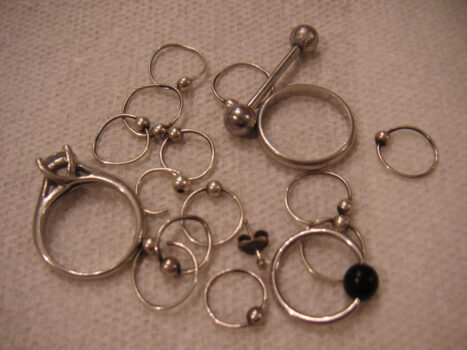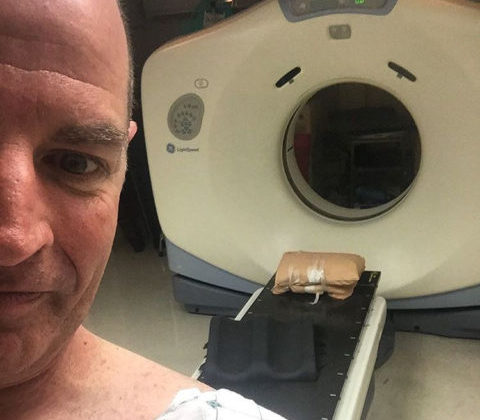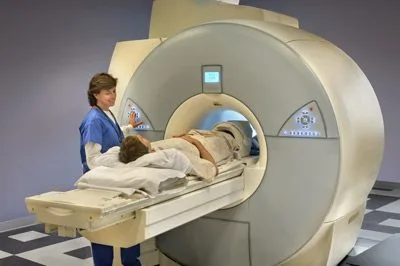Due to a recent traffic accident (where I was hit from behind in my car), I’ve been experiencing neck and lower back pain. My chiropractor recommended an MRI scan of those areas.
I had my first-ever MRI, and I’ll admit I was a tad nervous.
Mostly because of the claustrophobic thing. But also because of the magnetized machinery thing.
NOTE: The entire MRI scanner is magnetized such that it’s strong enough to send things like hospital gurneys, floor buffer machines, and office equipment flying across the room in the process of being sucked into the machine itself!
Those visuals — and stories about MRI scans like these — were stuck in my brain the entire time.
But, I also managed to find some humorous things about the whole process of getting an MRI.
In the event that you have to go in for an MRI scan in the near future, hopefully knowing these 13 things about MRI’s beforehand will help you have a quick and pleasant experience:
#1 – You Have To Remove Your Clothes
You have to change into one of those highly attractive backless hospital gowns. Well, it actually ties in the back, but I couldn’t figure out how to reach the ties up near my shoulder blades in back to actually tie it shut — so I was bare-shouldered across the back.
You can keep anything on that’s 100% cotton (undies, but no bras — most have underwires and metal clasps, even a t-shirt is okay). But what I wore that day didn’t work.
Once you’re lying down on the table, they cover your lower half with a blanket. (To keep the cool air off of your bare legs and feet, I suppose.) I laid there with my hands clenched firmly to the blanket which went up to about my waist.
Afterward, my hands and waist were actually slightly sweaty — a sign of how intensely I was grasping my “security” blanket (without even realizing it).
#2 – You Have To Remove (Almost) All Metal
Since the machine itself is basically one huge magnet (see images above), this one’s a given. But I was kind of surprised to find that they don’t actually check you over for metal anywhere.
Nor do you walk through a scanner or anything. (You’ve gotta admit, that would be one sure-fire way to guarantee you don’t have anything metal on, right?)
You do have to check a series of boxes stating that you don’t have things like a pacemaker or other medical implants.
Often overlooked items include:
- hair barrettes
- dental bridges or braces
- toe rings
- belly button rings
- “other” types of rings in “other” types of places
- some tattoos and permanent eyeliner
- shrapnel (…it’s on the list!)
Acceptable metals include:
- the metal that lies underneath crowns on teeth (I have plenty of these)
- any metal staples (so long as there’s at least 6 weeks of scar tissue built up)
Most orthopedic implants, even though they may be ferromagnetic, are fine because they are firmly embedded in bone. Even metal staples in most parts of the body are fine — once they have been in a patient for a few weeks (usually 6 weeks), enough scar tissue has formed to hold them in place.
– Source
It was interesting to try & notice any sensation I might get from the magnets on my highly metalicized teeth — but I felt none. (Which, for the record, I don’t understand why.)
#3 – You Can’t Move While You’re Being Scanned
I know, that’s a given too. But again, they don’t check. (Nor do they reprimand you if you do move.)
They don’t really “buckle you in” or lock you into position or anything. You simply lie on a table with your shoulders butted up to a thick plastic brace, and your neck and head naturally position themselves above that plastic brace. But it’s not confining at all.
I could’ve moved a great deal — especially my arms, hips, and legs. I could’ve even turned my head side-to-side, if I wasn’t careful. I think there was a very thick groove below my head, that more or less kept it into position. It was highly padded though, so I didn’t feel it.
I just think it would be easy to let your mind wander to the point that you might actually forget the importance of not moving a muscle while you’re in there.
#4 – Yes, You Can Breathe (It’s OK)
That might sound strange to you, but I also had a CAT scan once. For that, they said you cannot breathe during the actual moment the x-ray was taken. You had to literally hold your breath.
And one time, it was for a long time — so long that they had to advise you to err on the side of breathing, rather than to err on the side of passing out — if you felt that you couldn’t hold your breath that long. (I couldn’t.)
But with an MRI scan, you are allowed to — and even recommended to — breathe during the procedure.
#5 – You’ll Want To Put The Earplugs In Correctly
The foamy earplugs-on-a-string that they give you are practically worthless. That is, unless you know how to squish ’em up and form them to fit your own ears.
There is a secret. (I know, I use the same earplugs most nights — because I sleep with a snorer. I also use earplugs regularly at hubby’s NHRA races.)
Here’s the trick…
For one, you should dampen them first, before you squish them. Dampened earplugs are more easily shape-able. And after they’re placed in your ears, they will expand ever-so-slightly to perfectly fit your ears! I’m not kidding.
To do this, you would either want to:
- Keep your hands damp after leaving the bathroom/clothes changing room (because the earplugs are the first thing they give you as soon as you leave that room); or
- Ask for that wet washcloth that they give you to cover your eyes with (it helps block out the light from the inside of the cocoon, and it might also make you feel more relaxed).
#6 – It Helps If You Keep Your Eyes Closed
Not because of any harmful rays or anything, but for peace of mind.
The process of getting ready… putting in the earplugs… lying down on the table… and being rolled into the cocoon itself all happened so quickly, that I wasn’t prepared for what was about to take place.
While the technician was giving me a few last words of instruction about the MRI scan, I started rolling backwards into the cocoon itself. Since I was looking up (naturally), my very last visual was of everything closing in on me.
Kind of like the Alice in Wonderland doors that get smaller and smaller — the cocoon is shaped very wide at the outermost edge, but it gets significantly smaller and tighter the farther in you go. I didn’t need that image.
I wish I’d closed my eyes sooner, because I started to feel claustrophobic at first.
You have no choice at this point, but to replay in your head everything you’ve just heard:
- “Don’t move.”
- “There’s an intercom inside the machine, so talk loudly if you need us.”
- “Don’t move.”
- “It’s gonna be loud in there.”
This, combined with the unknown of what it was going to be like after he pushed the “Go” button — and my final visual of being completely enclosed by thick plastic — sort of became overwhelming all at the last moment.
Such is why #7 is so important…
#7 – Go To Your “Happy Place”
I wasn’t prepared to have to think of where my happy place might be. But it turns out, in moments of desperation, you can come up with something rather quickly.
Turns out, I have 2 happy places:
- Walking on the beach with Jim during the week we visited Pensacola in order to decide if we wanted to actually move there. (We did.)

- Enjoying my very first cruise with my good friend, Suzie. (Here, we’re “snuba”-diving in St. John, Virgin Islands.)

#8 – Find Creative Ways To Tune Out The Noise
The more engrossed you become reliving the experiences associated with your “happy place,” the less you actually realize the loud sounds around you.
But, the moment you’ve exhausted all of those fun memories and start scrambling to try & think of a new happy place, then you start to remember where you really are — and those loud sounds become deafening again (…even with the earplugs).
Actually, the sounds are more annoying than anything. The repetition makes them predictable which helps some. I found myself associating words with the actual sounds.
For example, one sound seemed like it was shouting “Batter! Batter! Batter” into my ears. (Which then took me to all of Jim’s softball games I’ve attended and the fun that we’ve had there.) Another seemed like it was saying “That’s right. That’s right. That’s right.”
Bizarre and meaningless in and of itself — but it helped to pass the time and take my mind off of the “bad” things — like what this MRI scan was going to reveal.
What does it really sound like in there?
The laser-firing sounds tend to occur in a series of repeated strengths and decibels. More or less, the machine is pounding out sounds all around your head. I’d liken it to hearing repeated rounds of machine guns firing — only they’re slightly muffled thanks to the earplugs.
But I didn’t leave the MRI scan with a headache or anything — so that proves that they’re not hurtful sounds.
#9 – Be Prepared For The Table To Move
At least once during each MRI (I had 2, one right after the other), the table suddenly started moving up or down in order to place the center of the cocoon on a slightly different part of the area currently being scanned. I guess some technicians might intercom you and let you know it’s about to happen, but mine didn’t.
It startled me at first, because my arms were lightly grazed by a different portion of the cocoon (which, by the way, is highly padded — so it didn’t hurt or anything). It just catches you off-guard, because something’s brushing past your arm… and you’re moving… and the table is sliding further into the cocoon.
The patient, lying on his or her back, slides into the bore on a special table. Whether or not the patient goes in head first or feet first, as well as how far in the magnet they will go, is determined by the type of exam to be performed.
– Source
I must say, I don’t know how anyone much larger than me could be comfortable inside that machine though. Larger people must feel really confined and claustrophobic!
I was in one like this:
#10 – Try To Enjoy The Cool Air
I believe the machine itself contains tiny fans within the cocoon which pipe lots of crisp, cool air on you the entire time. It’s not enough to make you chilly (in an already air-conditioned room, while wearing a backless hospital gown and bare feet), but it’s just enough to feel refreshing.
It’s a huge bonus — because it helps to keep you from realizing that you’re completely enclosed inside a claustrophobic capsule.
It’s like an illusion of fresh air. (It also went well with my “happy places” which all tended to be outdoorsy and beachy.)
#11 – Know That You’ll Be Done Quickly
When I called to make the appointment for my MRI, I was told that it would take at least an hour-and-a-half. I was having 2:
- 1 on my neck
- 1 on my lower back
In reality, it took less than 20 minutes to complete each one. For me, 40 minutes — for the 2 MRI’s — was just about the maximum amount of time I’d want to spend in that cocoon though. (I was running out of “happy places”.)
#12 – Be Nice To The Tech
I very much appreciated the fact that my technician treated the whole experience more or less like an amusement ride at Disney World: “Lie here… Put these in your ears… Don’t move… Hold on & enjoy the ride!”
And the tech’s last words to me (at the very moment the hydraulic table started sliding me deep into the cocoon part) were: “Just remember, it doesn’t move and nothing will touch you. It just makes a lot of noise, that’s all.”
I found that advice calmed me a bit and put me at ease. It reminded me of the fact that I was simply a person who’s lying flat on a table — and I had nothing to fear but all the silly noises going on around me.
#13 – There Will Be Different People In The Room When You’re Done
This may not be common, but just don’t be surprised if you find a strange man taking the blanket off your legs and staring you in the face when your MRI is all over.
What I mean is: the technician (a male) who got me situated on the table and familiarized me with all its parts was not the same technician (also male) who looked deep into my eyes as I emerged from the cocoon, trying to make sure that I was okay.
Coming out of the cocoon, I was finding it hard to adjust my eyes to the light after being in pitch-blackness for so long and I was finding it equally hard to focus on this stranger who was now wanting to strike up a conversation with me. (Might have also had something to do with the fact that I’d had loud pounding noises in my ears for 40 minutes straight — enough to disorient you when you come back to reality.)
In fact, I think I kinda got cheated out of a small part of the whole MRI experience. I mean, going into the prep phase, instruction phase, and everything prior to pushing the “Go” button, I had joked and chatted with the technician. I even created a short list of questions (about MRI’s) that I wanted to ask this guy when the MRI was over. He’d been receptive to my questions going in, and his answers were reassuring — and informative.
However, I had no relationship with this new guy — so I didn’t feel comfortable asking him any questions that I’d thought of while I was inside the machine. My questions went unanswered.
Questions I Still Have:
If you are having a head scan, it requires that the your head rest in the middle of the magnet leaving no room for headphones.
It was allergy season when I had my MRI and at the hospital I went to you had to walk outside to a separate adjoining building to get to the MRI room (the hospital was under construction). I’m over-the-top allergic to pollen & tree stuff, so this only aggravated my nasal activity (runny nose & itchiness). I spent most of the time inside that cocoon fearing that I might sneeze.
And you lock your locker with their (supplied) metal lock and metal key. And, to top it all off, there was no real “barrier” between the machine/capsule/cocoon and the area where I gave the girl the key to my locker (since I, obviously, couldn’t keep the key with me). Which leads me to ask… who is it I’m locking my stuff from? The very people I gave the key to, right?
And finally, here are the advantages and disadvantages of MRIs.










